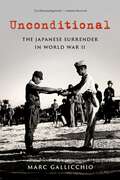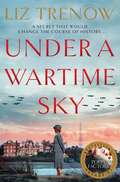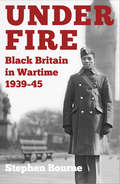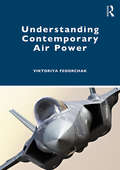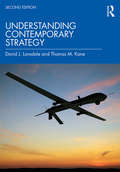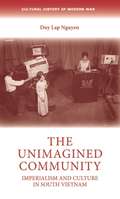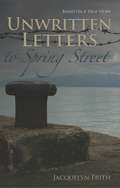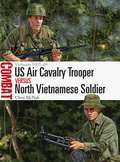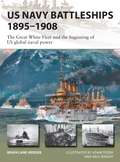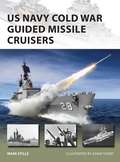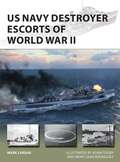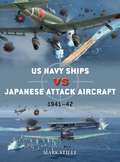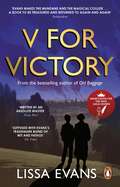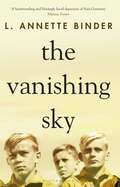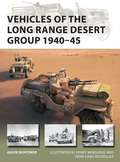- Table View
- List View
Uncommon Grit: A Photographic Journey Through Navy SEAL Training
by D. McBurnettRetired Navy SEAL and professional photographer Darren McBurnett takes readers behind the scenes into the elite SEAL training program, BUD/S, in Coronado, California. Striking, beautiful, and haunting, Uncommon Grit takes a unique, unprecedented look at the toughest training in the military -- and the world -- from the vantage point of someone who lived through it. Retired Navy SEAL Darren McBurnett includes vivid descriptions of both the physical and mental evolutions that occur as a result of the immensely challenging SEAL training process.His stunning photographs, partnered with his compelling insights and sharp sense of humor, allow the reader to laugh, cringe, gasp, and even envision themselves going through this extraordinary experience.
Unconditional: The Japanese Surrender in World War II (Pivotal Moments in American History)
by Marc GallicchioA new look at the drama that lay behind the end of the war in the Pacific Signed on September 2, 1945 aboard the American battleship USS Missouri in Tokyo Bay by Japanese and Allied leaders, the instrument of surrender that formally ended the war in the Pacific brought to a close one of the most cataclysmic engagements in history. Behind it lay a debate that had been raging for some weeks prior among American military and political leaders. The surrender fulfilled the commitment that Franklin Roosevelt had made in 1943 at the Casablanca conference that it be "unconditional." Though readily accepted as policy at the time, after Roosevelt's death in April 1945 support for unconditional surrender wavered, particularly among Republicans in Congress, when the bloody campaigns on Iwo Jima and Okinawa made clear the cost of military victory against Japan. Germany's unconditional surrender in May 1945 had been one thing; the war in the pacific was another. Many conservatives favored a negotiated surrender. Though this was the last time American forces would impose surrender unconditionally, questions surrounding it continued through the 1950s and 1960s--with the Korean and Vietnam Wars--when liberal and conservative views reversed, including over the definition of "peace with honor." The subject was revived during the ceremonies surrounding the 50th anniversary in 1995, and the Gulf and Iraq Wars, when the subjects of exit strategies and "accomplished missions" were debated. Marc Gallicchio reveals how and why the surrender in Tokyo Bay unfolded as it did and the principle figures behind it, including George C. Marshall and Douglas MacArthur. The latter would effectively become the leader of Japan and his tenure, and indeed the very nature of the American occupation, was shaped by the nature of the surrender. Most importantly, Gallicchio reveals how the policy of unconditional surrender has shaped our memory and our understanding of World War II.
Under a Wartime Sky
by Liz TrenowUnder a Wartime Sky is an enthralling historical novel by Liz Trenow, based on real-life events at a top-secret wartime research station. Telling the story of the heroes behind the discovery of radar, it’s perfect for readers of Kate Furnivall and Rachel Hore.Bawdsey Manor holds a secret.1936: the threat of war hangs over Europe. Churchill gathers the brightest minds in Britain at a grand house in Suffolk. Bound to complete secrecy, they work together on an invention that could mean victory for the Allies. Among them is Vic, a gifted but shy physicist who, for the first time, feels like he belongs.Local girl Kathleen wants to do more than serving tea and biscuits to ‘do her bit’. So when the Bawdsey team begin to recruit women to operate their top secret system, she dedicates herself to this life-or-death work. Kath and Vic form an unlikely friendship as the skies over Britain fill with German bombers. Little does Kath know just whose life she will change forever, one fateful night . . .Based on the real history of Bawdsey Manor, Under a Wartime Sky is a novel about courage, belonging and hope.Praise for Liz Trenow‘The characters shine . . . Fabulous’ - Dinah Jefferies‘It was a wrench to put the book down after the last beautifully written page’ - Gill Paul‘Trenow’s exquisite novel puts a real focus on the characters’ journeys’ - Woman
Under Fire: Black Britain in Wartime 1939–45
by Stephen BourneDuring the Second World War all British citizens were called upon to do their part for their country. Despite facing the discriminatory ‘colour bar’, many black civilians were determined to contribute to the war effort where they could, volunteering as air-raid wardens, fire-fighters, stretcher-bearers and first-aiders. Meanwhile, black servicemen and women, many of them volunteers from places as far away as Trinidad, Jamaica, Guyana and Nigeria, risked their lives fighting for the Mother Country in the air, at sea and on land. In Under Fire, Stephen Bourne draws on first-hand testimonies to tell the whole story of Britain’s black community during the Second World War, shedding light on a wealth of experiences from evacuees to entertainers, government officials, prisoners of war and community leaders. Among those remembered are men and women whose stories have only recently come to light, making Under Fire the definitive account of the bravery and sacrifices of black Britons in wartime.
Under the Mistletoe: The unforgettable and heartwarming Sunday Times bestselling Christmas saga (The Liverpool Sisters #2)
by Katie FlynnALL YOU NEED THIS CHRISTMAS: THE SECOND NOVEL IN THE HEART-WARMING NEW SERIES FROM BESTSELLING AUTHOR KATIE FLYNN____________Liverpool, 1940When war comes to Britain, Jessica Wilson and her friend Ruby seize the opportunity to leave behind the orphanage they grew up in and start new lives in the NAAFI. With only forged papers as identification the girls expect to be turned away but are delighted with an offer of work.For the first time in their lives they experience real independence and it isn't long before they're spending their evenings enjoying the delights of Liverpool.When Jessica meets the handsome Tom, she feels as though her life is complete, but after a chance encounter with a friend, she soon learns that not everything is as it seems. As Jessica begins to uncover the truth, she unravels a web of lies, starting with the night of her birth . . . ____________ Praise for Katie Flynn'Packed with romance and poignancy' Woman'One of the best Liverpool writers' Liverpool Echo'Heart-warming' Take a Break'A poignant war-time romance' Daily Express
Understanding Contemporary Air Power
by Viktoriya FedorchakThis book aims to explain air power to both military and civilian audiences in an accessible manner, approaching the topic in a balanced and systematic way. The past 100 years illustrates that air power is an inevitable feature of any type of modern warfare. It has a key role to play in any of the three main operational environments: conventional (inter-state) wars, peace-support operations, and counterinsurgencies. This book examines the strengths and challenges of using air power in these situations, and each type of operation is explained using modern and historical examples, with an emphasis on the relevant lessons for the contemporary and future use of air power. The book also looks into the complexity of media coverage of air warfare and changes in the public perception of air power in recent years. The specifics of structuring national air forces is also discussed, along with the future of air power based on current trends. One of the enduring themes in the book is the necessity of inter-service and cross-domain integration, emphasizing the increasingly important role of cyber and space domains in the future of network-centric warfare. This book will be essential reading for students of air power and air warfare, and recommended reading for students of international security, strategic studies, defence studies, and foreign policy.
Understanding Contemporary Air Power
by Viktoriya FedorchakThis book aims to explain air power to both military and civilian audiences in an accessible manner, approaching the topic in a balanced and systematic way. The past 100 years illustrates that air power is an inevitable feature of any type of modern warfare. It has a key role to play in any of the three main operational environments: conventional (inter-state) wars, peace-support operations, and counterinsurgencies. This book examines the strengths and challenges of using air power in these situations, and each type of operation is explained using modern and historical examples, with an emphasis on the relevant lessons for the contemporary and future use of air power. The book also looks into the complexity of media coverage of air warfare and changes in the public perception of air power in recent years. The specifics of structuring national air forces is also discussed, along with the future of air power based on current trends. One of the enduring themes in the book is the necessity of inter-service and cross-domain integration, emphasizing the increasingly important role of cyber and space domains in the future of network-centric warfare. This book will be essential reading for students of air power and air warfare, and recommended reading for students of international security, strategic studies, defence studies, and foreign policy.
Understanding Contemporary Strategy
by David J. Lonsdale Thomas M. KaneThis textbook provides a comprehensive introduction to modern strategy, covering the context, theory, and practice of military strategy in all its different forms. Covering all the main issues in the field, the book explores the major themes through a combination of classical and modern strategic theory, history, and current practice. It is split into three main sections: The first provides the context for contemporary strategy and includes discussions of the human, technological, intelligence, ethical, and grand strategic dimensions. The second part explores the theory and practice of strategy in different geographical domains, including land, sea, air, space, and cyberspace. The final part engages with three of the most challenging forms of strategy in the contemporary era: nuclear weapons, terrorism, and insurgency. This second edition brings the book up to date by including discussions of the rise and fall of the Islamic State of Iraq and Syria (ISIS); the emergence of robotics and artificial intelligence; major events in space and cyberspace; and the growing profile of nuclear weapons. Each chapter presents the reader with a succinct summary of the topic, provides a challenging analysis of current issues, and finishes with key points, questions for discussion, and further reading. This book will be essential reading for upper-level students of strategic studies, war studies, military history, and international security.
Understanding Contemporary Strategy
by Thomas M. Kane David J. LonsdaleThis textbook provides a comprehensive introduction to modern strategy, covering the context, theory, and practice of military strategy in all its different forms. Covering all the main issues in the field, the book explores the major themes through a combination of classical and modern strategic theory, history, and current practice. It is split into three main sections: The first provides the context for contemporary strategy and includes discussions of the human, technological, intelligence, ethical, and grand strategic dimensions. The second part explores the theory and practice of strategy in different geographical domains, including land, sea, air, space, and cyberspace. The final part engages with three of the most challenging forms of strategy in the contemporary era: nuclear weapons, terrorism, and insurgency. This second edition brings the book up to date by including discussions of the rise and fall of the Islamic State of Iraq and Syria (ISIS); the emergence of robotics and artificial intelligence; major events in space and cyberspace; and the growing profile of nuclear weapons. Each chapter presents the reader with a succinct summary of the topic, provides a challenging analysis of current issues, and finishes with key points, questions for discussion, and further reading. This book will be essential reading for upper-level students of strategic studies, war studies, military history, and international security.
The unimagined community: Imperialism and culture in South Vietnam (Cultural History of Modern War)
by Duy Lap NguyenThe unimagined community proposes a reexamination of the Vietnam War from a perspective that has been largely excluded from historical accounts of the conflict, that of the South Vietnamese. Challenging the conventional view that the war was a struggle between the Vietnamese people and US imperialism, the study presents a wide-ranging investigation of South Vietnamese culture, from political philosophy and psychological warfare to popular culture and film. Beginning with a genealogy of the concept of a Vietnamese “culture,” as the latter emerged during the colonial period, the book concludes with a reflection on the rise of popular culture during the American intervention. Reexamining the war from the South Vietnamese perspective, The unimagined community pursues the provocative thesis that the conflict, in this early stage, was not an anti-communist crusade, but a struggle between two competing versions of anticolonial communism.
The unimagined community: Imperialism and culture in South Vietnam (Cultural History of Modern War)
by Duy Lap NguyenThe unimagined community proposes a reexamination of the Vietnam War from a perspective that has been largely excluded from historical accounts of the conflict, that of the South Vietnamese. Challenging the conventional view that the war was a struggle between the Vietnamese people and US imperialism, the study presents a wide-ranging investigation of South Vietnamese culture, from political philosophy and psychological warfare to popular culture and film. Beginning with a genealogy of the concept of a Vietnamese “culture,” as the latter emerged during the colonial period, the book concludes with a reflection on the rise of popular culture during the American intervention. Reexamining the war from the South Vietnamese perspective, The unimagined community pursues the provocative thesis that the conflict, in this early stage, was not an anti-communist crusade, but a struggle between two competing versions of anticolonial communism.
Unlocking The Ex-Army Doc's Heart (Mills And Boon Medical Ser.)
by Juliette HylandIt will take someone special… …to thaw her frozen heart!
Unsettled Land: From Revolution to Republic, the Struggle for Texas
by Sam W. HaynesA bold new history of the origins and aftermath of the Texas Revolution, revealing how Indians, Mexicans, and Americans battled for survival in one of the continent&’s most diverse regions The Texas Revolution has long been cast as an epic episode in the origins of the American West. As the story goes, larger-than-life figures like Sam Houston, David Crockett, and William Barret Travis fought to free Texas from repressive Mexican rule. In Unsettled Land, historian Sam Haynes reveals the reality beneath this powerful creation myth. He shows how the lives of ordinary people—white Americans, Mexicans, Native Americans, and those of African descent—were upended by extraordinary events over twenty-five years. After the battle of San Jacinto, racial lines snapped taut as a new nation, the Lone Star republic, sought to expel Indians, marginalize Mexicans, and tighten its grip on the enslaved. This is a revelatory and essential new narrative of a major turning point in the history of North America.
Unsettled Land: From Revolution to Republic, the Struggle for Texas
by Sam W. HaynesA bold new history of the origins and aftermath of the Texas Revolution, revealing how Indians, Mexicans, and Americans battled for survival in one of the continent&’s most diverse regions The Texas Revolution has long been cast as an epic episode in the origins of the American West. As the story goes, larger-than-life figures like Sam Houston, David Crockett, and William Barret Travis fought to free Texas from repressive Mexican rule. In Unsettled Land, historian Sam Haynes reveals the reality beneath this powerful creation myth. He shows how the lives of ordinary people—white Americans, Mexicans, Native Americans, and those of African descent—were upended by extraordinary events over twenty-five years. After the battle of San Jacinto, racial lines snapped taut as a new nation, the Lone Star republic, sought to expel Indians, marginalize Mexicans, and tighten its grip on the enslaved. This is a revelatory and essential new narrative of a major turning point in the history of North America.
Unwritten Letters to Spring Street
by Jacquelyn FrithDecember 1941. Jack Frith left his family and his life to go to war like so many others, uncertain whether he would come home. Whilst in a convoy bound for the Middle East the Japanese attacked Pearl Harbour, triggering Allied entry into the Pacific War. Hastily regrouped and ordered to the Far East, the now ill-equipped convoy peeled off for Java and elsewhere. Slipping the moorings, Jack could not have known that years of captivity and brutality, starvation and forced labour, and yet worse, awaited him. This is no cry for revenge but justice, laying bare actions and exposing inaction, demanding long overdue apologies and uncovering past atrocities. It is also a moment of reflection on the forgotten armies of the Far East, in remembering each subsequent generation owes a great unpaid debt of gratitude to those who gave so much for our present freedom. The price of that freedom was by no means free.
US Air Cavalry Trooper vs North Vietnamese Soldier: Vietnam 1965–68 (Combat)
by Chris McNabThe tactics and technologies of modern air assault – vertical deployment of troops by helicopter or similar means – emerged properly during the 1950s in Korea and Algeria. Yet it was during the Vietnam War that helicopter air assault truly came of age and by 1965 the United States had established fully airmobile battalions, brigades, and divisions, including the 1st Cavalry Division (Airmobile).This division brought to Vietnam a revolutionary new speed and dexterity in battlefield tactics, using massed helicopters to liberate its soldiers from traditional overland methods of combat manoeuvre. However, the communist troops adjusted their own thinking to handle airmobile assaults. Specializing in ambush, harassment, infiltration attacks, and small-scale attrition, the North Vietnamese operated with light logistics and a deep familiarity with the terrain. They optimized their defensive tactics to make landing zones as hostile as possible for assaulting US troops, and from 1966 worked to draw them into 'Hill Traps', extensive kill zones specially prepared for defence-in-depth. By the time the 1st Cavalry Division (Airmobile) withdrew from Vietnam in 1972, it had suffered more casualties than any other US Army division. Featuring specially commissioned artwork, archive photographs, and full-colour battle maps, this study charts the evolution of US airmobile tactics pitted against North Vietnamese countermeasures. The two sides are analysed in detail, including training, logistics, weaponry, and organization.
US Navy Battleships 1895–1908: The Great White Fleet and the beginning of US global naval power (New Vanguard #286)
by Brian Lane HerderThe last predreadnought battleships of the US Navy were critical to the technological development of US battleships, and they were the first tool of international hard power wielded by the United States, a nation which would eventually become the world's dominant political and military power of the 20th century. These battleships were the stars of the 1907–09 Great White Fleet circumnavigation, in which the emerging power and reach of the US Navy was displayed around the world. They also took part in the bombardment and landings at Veracruz, some served as convoy escorts in World War I, and the last two were transferred to the Hellenic Navy and were sunk during World War II. This book examines the design, history, and technical qualities of the final six classes of US predreadnought battleships, all of which were involved in the circumnavigation of the Great White Fleet. These classes progressively closed the quality gap with European navies – the Connecticuts were the finest predreadnought battleships ever built – and this book also compares and contrasts US predreadnought battleships to their foreign contemporaries. Packed with illustrations and specially commissioned artwork, this is an essential guide to the development of US Navy Battleships at the turn of the twentieth century.
US Navy Cold War Guided Missile Cruisers (New Vanguard #278)
by Mark StilleFaced with an increasingly formidable anti-ship cruise missile threat from the Soviet Union in the early days of the Cold War, and with the recent memory of the kamikaze threat from World War II, the USN placed a great priority on developing air defence cruise missiles and getting them to sea to protect the fleet. The first of these missiles were sizable, necessitating large ships to carry them and their sensors, which resulted in the conversion of a mix of heavy and light cruisers. These ships, tasked with protecting carrier groups and acting as flagships, entered service from 1955 and served until 1980. The cruisers served in the front lines of the Cold War and many saw combat service, engaging in surface actions from Vietnam to the Persian Gulf. Complementing the conventionally-powered missile cruisers was a much smaller number of expensive nuclear-powered cruisers, including the Long Beach, the USN's largest-ever missile cruiser. Until replaced by the Ticonderoga and Burke classes of Aegis ships, the USN's 38 missile cruisers were the most capable and important surface combatants in the fleet and served all over the globe during the Cold War. Using specially commissioned artwork and meticulous research, this illustrated title explores the story of these cruisers in unparalleled detail, revealing the history behind their development and employment.
US Navy Destroyer Escorts of World War II (New Vanguard #289)
by Mark LardasThe Destroyer Escort was the smallest ocean-going escort built for the United States Navy – a downsized destroyer with less speed, fewer guns, and fewer torpedoes than its big brother, the fleet destroyer. Destroyer escorts first went into production because the Royal Navy needed an escort warship which was larger than a corvette, but which could be built faster than a destroyer. Lacking the shipyards to build these types of ships in Britain, they ordered them in the US. Once the US unexpectedly entered World War II, its navy suddenly also needed more escort warships, even warships less capable than destroyers, and the destroyer escort was reluctantly picked to fill the gap. Despite the Navy's initial reservations, these ships did yeoman service during World War II, fighting in both the Atlantic and Pacific, taking on both U-boat and Japanese submarines and serving as the early warning pickets against kamikazes later in the war. They also participated in such dramatic actions as the Battle of Samar (where a group of destroyers and destroyer escorts fought Japanese battleships and cruisers to protect the escort carriers they were shielding) and the capture of the U-505 (the only major naval vessel captured at sea by the US Navy). The destroyer escorts soldiered on after World War II in both the United States Navy and a large number of navies throughout the world, with several serving into the twenty-first century. This book tells the full story of these plucky ships, from their design and development to their service around the world, complete with stunning illustrations and contemporary photographs.
US Navy Ships vs Japanese Attack Aircraft: 1941–42 (Duel #105)
by Mark StilleThe striking power of the Imperial Japanese Navy's carrier-based attack aircraft was established at Pearl Harbor, and the IJN's carrier-based torpedo and dive-bombers showed their prowess again at the Battle of Coral Sea when they sank the US Navy carrier USS Lexington and damaged the carrier USS Yorktown. Even at the disastrous Battle of Midway, the relatively small number of IJNAF attack- and torpedo-bombers that were launched against the US fleet proved that they remained a potent force by heavily damaging Yorktown again, which allowed an IJN submarine to sink the carrier. At Guadalcanal, IJNAF carrier-based aircraft sank the carrier USS Hornet and badly damaged USS Enterprise twice. However, throughout 1942, US Navy ship defences brought down an increasing number of attacking IJNAF aircraft. The final major battle of the year, the Battle of Santa Cruz, exacted crippling losses on the IJN, setting the stage for the eclipse of the IJNAF's highly trained and effective aviation attack forces. Packed with illustrations and contemporary photographs, this engrossing volume details the design, tactics, and operational records of both the US Navy ships and the IJNAF aircraft which attacked them over the year following Pearl Harbor.
V for Victory: The delightful and moving novel from the Sunday Times bestseller
by Lissa Evans'At once funny and moving: the brisk kindness of the wardens will bring a lump to your throat. I could not have loved it more' Susie SteinerIt’s late 1944. Hitler’s rockets are slamming down on London with vicious regularity and it’s the coldest winter in living memory. Allied victory is on its way, but it’s bloody well dragging its feet.In a large house next to Hampstead Heath, Vee Sedge is just about scraping by, with a herd of lodgers to feed, and her young charge Noel ( almost fifteen ) to clothe and educate. When she witnesses a road accident and finds herself in court, the repercussions are both unexpectedly marvellous and potentially disastrous – disastrous because Vee is not actually the person she’s pretending to be, and neither is Noel.The end of the war won’t just mean peace, but discovery...With caustic wit and artful storytelling, Lissa Evans elegantly summons a time when the world could finally hope to emerge from the chaos of war. As sharply comic as Old Baggage and emotionally poignant as Crooked Heart, V For Victory once again shows Lissa Evans to be one of our most brilliant and subtle writers.__________________________________Lissa Evans' writing is:Wise and witty - Sarah Hughes, ObserverOriginal and so timely. And it made me weep at the end. - JoJo MoyesBittersweet and comic. - GuardianInspiring, moving, warm and wry...wonderful! - Marian KeyesBeautifully written. -Sunday MirrorThoughtful, funny...invigoratingly fresh. - Sunday Times
The Vanishing Sky
by L. Annette BinderA story of the shattering impact of war on one German family, The Vanishing Sky is a deeply moving portrait of why decent, caring people falter when confronted by evil. They've wrecked the world, these men, and still they're not done. They'd take the sky if they could.Germany, 1945, and the bombs are falling. In Heidenfeld, Etta and her husband Josef roam an empty nest: their eldest son Max is fighting on the frontlines, while fifteen-year-old Georg has swapped books for guns at a Nürnberg school for the Hitler Youth. At home, news of the war provokes daily doses of fear as the planes grow closer, taking one city after the next.When Max is unexpectedly discharged, Etta is relieved to have her eldest home and safe. But soon after he arrives, it's clear that the boy who left is not the same returned. With Georg a hundred miles away and a husband confronting his own difficult feelings toward patriotic duty, Etta alone must gather the pieces of a splintering family, determined to hold them together in the face of an uncertain future.
The Vanishing Sky
by L. Annette BinderFor readers of Warlight and The Invisible Bridge, an intimate, harrowing story about a family of German citizens during World War II.“There was no shelter without her sons.”In 1945, as the war in Germany nears its violent end, the Huber family is not yet free of its dangers or its insidious demands. Etta, a mother from a small, rural town, has two sons serving their home country: her elder, Max, on the Eastern front, and her younger, Georg, at a school for Hitler Youth. When Max returns from the front, Etta quickly realizes that something is not right-he is thin, almost ghostly, and behaving very strangely. Etta strives to protect him from the Nazi rule, even as her husband, Josef, becomes more nationalistic and impervious to Max's condition. Meanwhile, miles away, her younger son Georg has taken his fate into his own hands, deserting his young class of battle-bound soldiers to set off on a long and perilous journey home.The Vanishing Sky is a World War II novel as seen through a German lens, a story of the irreparable damage of war on the home front, and one family's participation-involuntary, unseen, or direct-in a dangerous regime. Drawing inspiration from her own father's time in the Hitler Youth, L. Annette Binder has crafted a spellbinding novel about the choices we make for country and for family.
The Variety Girls
by Tracy BainesEven with the country at war, the show must go on... After the tragic death of her father, aspiring singer Jessie Delaney has been forced to live with her bullying aunt and dreams of getting the break of a lifetime to escape. When she's cast as one of the Variety Girls in a new show at the Empire Theatre, Jessie hopes this is the new beginning she's been longing for. But following her dreams on stage will mean being separated from sweetheart Harry.As she starts her new job, it's not long before she forms a close-knit friendship with Frances and Dolly, although the girls soon find that life in the theatre isn't always glamorous. And with the country on the brink of war, everyone is facing an uncertain future. Can friendship help Jessie through the challenges ahead?A gritty and heartwarming saga perfect for readers of Elaine Everest and Daisy Styles.
Vehicles of the Long Range Desert Group 1940–45 (New Vanguard #291)
by Gavin MortimerThe Long Range Desert Group was one of the most famous special units of World War II, operating heavily modified vehicles deep behind enemy lines to gather intelligence and support the raids of David Stirling's new Special Air Service.When war broke out, a pre-war explorer and army officer, Ralph Bagnold, convinced Middle East Command of the need for a reconnaissance force to penetrate into Italian-held desert. Bagnold tested four types of vehicles over rocks and through soft sand to find the best one for his new unit. Bagnold selected the Chevrolet WB (30 CWT) as the signature vehicle of the Long Range Desert Group because it is "fast, simple and easy to handle". With left-hand steering, horizontal grill and round fenders on the rear wheels, these trucks proved themselves popular and effective. The durability of the Chevrolets was demonstrated in January 1941 with an audacious raid on the Italian fort/air strip at Murzuk, hundreds of miles behind enemy lines.This book explains the detail of all the vehicles of the LRDG, as well as their modifications, driving techniques, and special kit for surviving behind enemy lines in one of the most hostile environments on earth.

